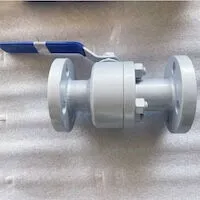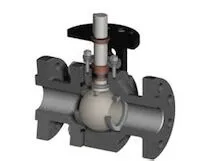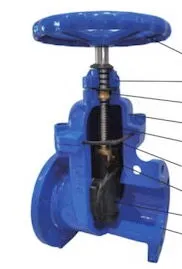Valves for Heating Engineering
May 14, 2024
Heating engineering is a crucial aspect of modern society, providing comfort and warmth to homes, offices, and industrial buildings. The field encompasses a wide range of technologies and systems designed to efficiently heat spaces while minimizing energy consumption. One key aspect of heating engineering is the design and installation of heating systems, including boilers, furnaces, heat pumps, and radiant heating systems. Engineers must consider factors such as building size, insulation levels, climate conditions, and energy costs when designing these systems to ensure optimal performance. There are various types of valves used in heating engineering, including ball valves, gate valves, globe valves, check valves, and butterfly valves. Each type serves a specific purpose and offers unique benefits depending on the application.
Ball valves
A ball valve is named because the valve spool is a ball with a through cavity, which is a new type of valve that is gradually being widely used. This sphere is connected to the valve stem of the valve. The valve spool rotates at an angle of 90 by moving the valve stem. At this time, the valve is in an open or closed state, thereby controlling the flow of the medium in the heating project. In fact, ball valves and gate valves have the same function, but they also have advantages that gate valves do not have, such as small sizes and easy operation. This is also the main reason why ball valves are favoured in heating engineering. At present, there are two main types of ball valves: one is a floating ball valve, and the other is a trunnion ball valve. Ball valves are generally used in key positions in heating projects, such as important locations in heating projects, access ports of thermal stations
Gate valves
Gate valves are essential components in heating engineering systems, providing a means to control the flow of water or steam. These valves are designed with a gate-like mechanism that can be raised or lowered to either allow or restrict the flow of fluid through the system. One of the key advantages of gate valves is their ability to provide a tight seal when closed, preventing any leakage of fluid. This makes them ideal for use in heating systems where precise control over the flow of water or steam is necessary. Gate valves are also known for their durability and reliability, making them a popular choice for heating engineers. They are able to withstand high temperatures and pressures without compromising their performance.
Globe valves
Globe valves have been a staple in heating engineering for decades due to their reliable performance and versatility. These valves are commonly used in heating systems to regulate the flow of hot water or steam, making them essential components in maintaining optimal temperatures within buildings. One of the key advantages of globe valves is their ability to provide precise control over flow rates, allowing for efficient heat distribution throughout a system. This level of control is crucial in ensuring that heating systems operate at peak efficiency, ultimately reducing energy costs and minimizing environmental impact. Additionally, globe valves are known for their durability and resistance to wear and tear, making them ideal for long-term use in heating applications. Their simple design also makes them easy to install and maintain, further adding to their appeal in the field of heating engineering.
Check valves
Check valves are a crucial component in heating engineering systems, ensuring the proper flow of fluids and preventing backflow. These valves are designed to allow fluid to flow in only one direction, preventing the reverse flow that can cause damage to equipment and disrupt the efficiency of heating systems. In heating engineering, check valves are commonly used in boiler systems, radiant heating systems, and hydronic heating systems. They play a key role in maintaining the optimal performance of these systems by regulating the flow of hot water or steam. Check valves come in various designs, including swing check valves, lift check valves, and ball check valves. Each type has its unique advantages and applications, but all serve the same essential function of controlling fluid flow. Overall, check valves are an indispensable component in heating engineering that ensures the safe and efficient operation of heating systems.
Butterfly valves
A butterfly valve is one of the most used valves in heating engineering. Its disc is disc-shaped, and the valve disc is connected to a valve stem. The operator rotates the valve stem to make the valve seat rotate, so that the medium in heating engineering can be connected or cut off. The butterfly valve can control the flow of the medium through the rotation of the valve seat. Compared with the above valves, the butterfly valve has the easiest operation. However, when the valve seat is fully open, the scouring and corrosion of the medium often affect the valve seat. There are two common types of sealed butterfly valves. One is a triple eccentric metal seated butterfly valve, and the other is a rubber soft sealed butterfly valve. The triple eccentricity refers to the positional deviation of the valve shaft and valve plate in the valve. Under normal circumstances, each valve has only one eccentricity, that is, the centerline and the centerline of the sealing surface are deviated. However, valves with higher performance will have two eccentricities, that is, coupled with the deviation of the centerline of the valve shaft and that of the valve, resulting in two eccentricities. After the valve plate is opened to an angle of 20 or more, the sealing lines are separated from each other, thereby reducing friction in the valve. On the basis of the double eccentricity, the inclined cone eccentricity is added to form the triple eccentricity. In this way, when the valve is at an angle of 90, the sealing lines can be separated from each other, minimizing the friction when the valve is working, and at the same time, it can also achieve scientific and rapid closing with the smallest torque angle. The disc of the rubber soft seated butterfly valve is generally made of electroplated ductile iron, and the sealing ring rubber. Different sealing made from different have different properties. Common sealing materials include nitrile rubber, ethylene-propylene rubber, and heat-resistant ethylene-propylene rubber. Different sealing materials correspond to different temperatures. The rubber soft seated butterfly valve is small and light, and there is no need to distinguish the direction during installation. It is a type of butterfly valve that is relatively easy to use.
Ball valves
A ball valve is named because the valve spool is a ball with a through cavity, which is a new type of valve that is gradually being widely used. This sphere is connected to the valve stem of the valve. The valve spool rotates at an angle of 90 by moving the valve stem. At this time, the valve is in an open or closed state, thereby controlling the flow of the medium in the heating project. In fact, ball valves and gate valves have the same function, but they also have advantages that gate valves do not have, such as small sizes and easy operation. This is also the main reason why ball valves are favoured in heating engineering. At present, there are two main types of ball valves: one is a floating ball valve, and the other is a trunnion ball valve. Ball valves are generally used in key positions in heating projects, such as important locations in heating projects, access ports of thermal stations
Gate valves
Gate valves are essential components in heating engineering systems, providing a means to control the flow of water or steam. These valves are designed with a gate-like mechanism that can be raised or lowered to either allow or restrict the flow of fluid through the system. One of the key advantages of gate valves is their ability to provide a tight seal when closed, preventing any leakage of fluid. This makes them ideal for use in heating systems where precise control over the flow of water or steam is necessary. Gate valves are also known for their durability and reliability, making them a popular choice for heating engineers. They are able to withstand high temperatures and pressures without compromising their performance.
Globe valves
Globe valves have been a staple in heating engineering for decades due to their reliable performance and versatility. These valves are commonly used in heating systems to regulate the flow of hot water or steam, making them essential components in maintaining optimal temperatures within buildings. One of the key advantages of globe valves is their ability to provide precise control over flow rates, allowing for efficient heat distribution throughout a system. This level of control is crucial in ensuring that heating systems operate at peak efficiency, ultimately reducing energy costs and minimizing environmental impact. Additionally, globe valves are known for their durability and resistance to wear and tear, making them ideal for long-term use in heating applications. Their simple design also makes them easy to install and maintain, further adding to their appeal in the field of heating engineering.
Check valves
Check valves are a crucial component in heating engineering systems, ensuring the proper flow of fluids and preventing backflow. These valves are designed to allow fluid to flow in only one direction, preventing the reverse flow that can cause damage to equipment and disrupt the efficiency of heating systems. In heating engineering, check valves are commonly used in boiler systems, radiant heating systems, and hydronic heating systems. They play a key role in maintaining the optimal performance of these systems by regulating the flow of hot water or steam. Check valves come in various designs, including swing check valves, lift check valves, and ball check valves. Each type has its unique advantages and applications, but all serve the same essential function of controlling fluid flow. Overall, check valves are an indispensable component in heating engineering that ensures the safe and efficient operation of heating systems.
Butterfly valves
A butterfly valve is one of the most used valves in heating engineering. Its disc is disc-shaped, and the valve disc is connected to a valve stem. The operator rotates the valve stem to make the valve seat rotate, so that the medium in heating engineering can be connected or cut off. The butterfly valve can control the flow of the medium through the rotation of the valve seat. Compared with the above valves, the butterfly valve has the easiest operation. However, when the valve seat is fully open, the scouring and corrosion of the medium often affect the valve seat. There are two common types of sealed butterfly valves. One is a triple eccentric metal seated butterfly valve, and the other is a rubber soft sealed butterfly valve. The triple eccentricity refers to the positional deviation of the valve shaft and valve plate in the valve. Under normal circumstances, each valve has only one eccentricity, that is, the centerline and the centerline of the sealing surface are deviated. However, valves with higher performance will have two eccentricities, that is, coupled with the deviation of the centerline of the valve shaft and that of the valve, resulting in two eccentricities. After the valve plate is opened to an angle of 20 or more, the sealing lines are separated from each other, thereby reducing friction in the valve. On the basis of the double eccentricity, the inclined cone eccentricity is added to form the triple eccentricity. In this way, when the valve is at an angle of 90, the sealing lines can be separated from each other, minimizing the friction when the valve is working, and at the same time, it can also achieve scientific and rapid closing with the smallest torque angle. The disc of the rubber soft seated butterfly valve is generally made of electroplated ductile iron, and the sealing ring rubber. Different sealing made from different have different properties. Common sealing materials include nitrile rubber, ethylene-propylene rubber, and heat-resistant ethylene-propylene rubber. Different sealing materials correspond to different temperatures. The rubber soft seated butterfly valve is small and light, and there is no need to distinguish the direction during installation. It is a type of butterfly valve that is relatively easy to use.
Previous: Titanium Alloy Globe Check Valves
Next: Ceramic Valves for Wastewater Recycling & Corrosive Media Treatment



